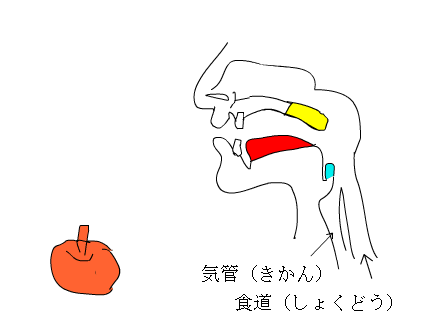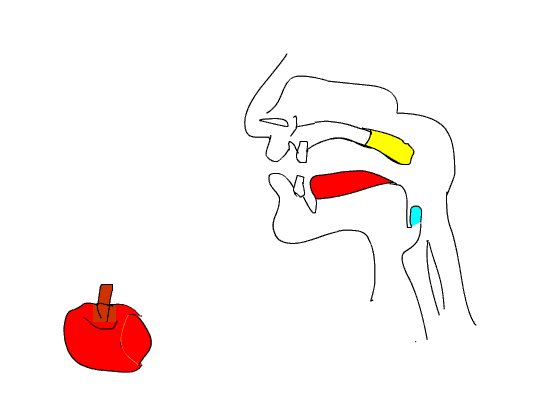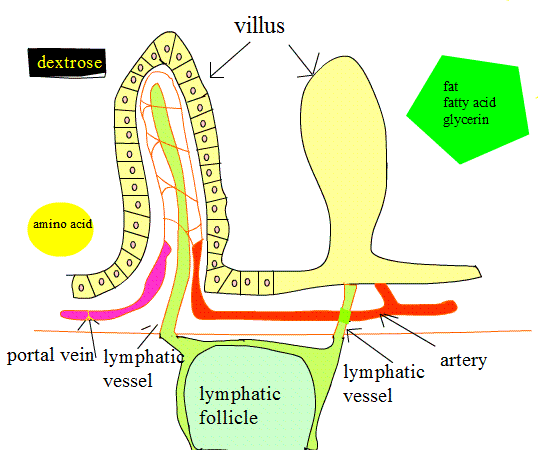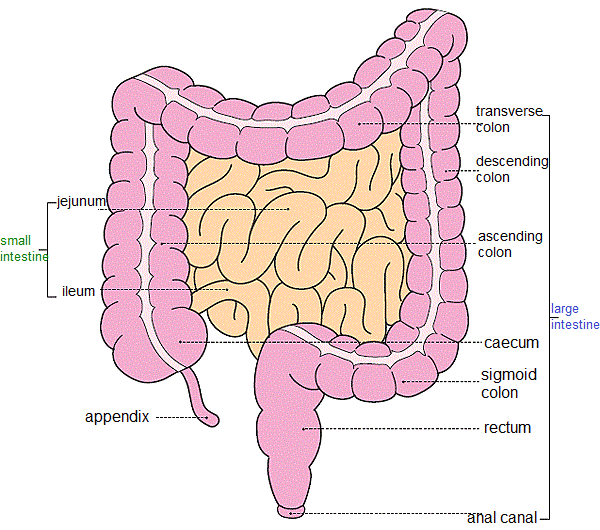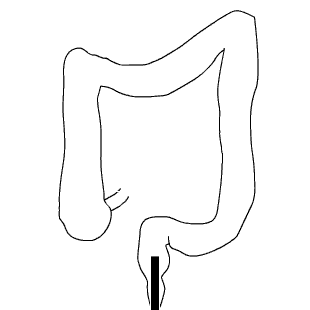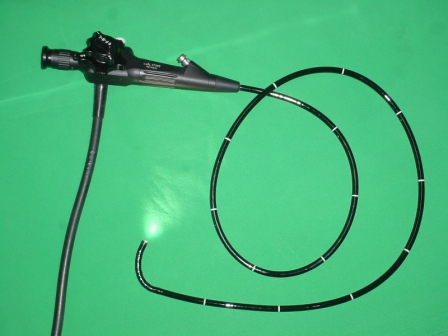Let’s study about a digestive system
Digestion means to decompose various nutrition contained in food to what can be taken in in the body when we eat it. And it is also digestion to take out unnecessary things as stool outside a body from anus. |
||||||||||||||||||||||||||||||||||||||||||||||||||||||||||||||||||||||||||||||||||||||||||||||||
There are two kinds in digestion. 『Mechanical digestion』 『Chemical digestion』 |
||||||||||||||||||||||||||||||||||||||||||||||||||||||||||||||||||||||||||||||||||||||||||||||||
| Mechanical digestion It is breaking food finely, mixing digestive fluids with this, and making it move to a downward gastrointestinal tract gradually. |
||||||||||||||||||||||||||||||||||||||||||||||||||||||||||||||||||||||||||||||||||||||||||||||||
The left moving image is small intestinal movement. The food which came through an esophagus and the stomach becomes finer by a small intestine, nutritive substance is absorbed, and it is sent to the large intestine. There are three ways in mechanical digestion. They are peristalsis, segmental movement and pendulum motion. As for right movement, three motions are mixed. |
||||||||||||||||||||||||||||||||||||||||||||||||||||||||||||||||||||||||||||||||||||||||||||||||
Chemical digestion Starch of the food, lipid, a protein are decomposed to the small thing which it is easy to take in in the small intestine respectively by a digestive enzyme existing in the place in the left column of the table shown below. Carbohydrates that is starch, lipid that is fat, protein that is meat as food.
|
||||||||||||||||||||||||||||||||||||||||||||||||||||||||||||||||||||||||||||||||||||||||||||||||
The places and names of enzyme |
||||||||||||||||||||||||||||||||||||||||||||||||||||||||||||||||||||||||||||||||||||||||||||||||
|
||||||||||||||||||||||||||||||||||||||||||||||||||||||||||||||||||||||||||||||||||||||||||||||||
| Although the bile secreted from the gallbladder is involved in digestion of lipid, does not do the function of digestion itself. Bile is emulsified so that the lipid and water which are not usually mixed may be mixed easily, and it is serving to help digestion of lipid. In other words, oil is changed into the state of melting into water, and oil is absorbed in the body. |
||||||||||||||||||||||||||||||||||||||||||||||||||||||||||||||||||||||||||||||||||||||||||||||||
Well, get back to talking about, let’s think from the place where food is taken in from a mouth. |
||||||||||||||||||||||||||||||||||||||||||||||||||||||||||||||||||||||||||||||||||||||||||||||||
One pipe following from a mouth to anus is the gastrointestinal tract. And this gastrointestinal tract, and the organ (salivary glands), the liver, the gallbladder and the pancreas attached to this are collectively called a digestive system. |
||||||||||||||||||||||||||||||||||||||||||||||||||||||||||||||||||||||||||||||||||||||||||||||||
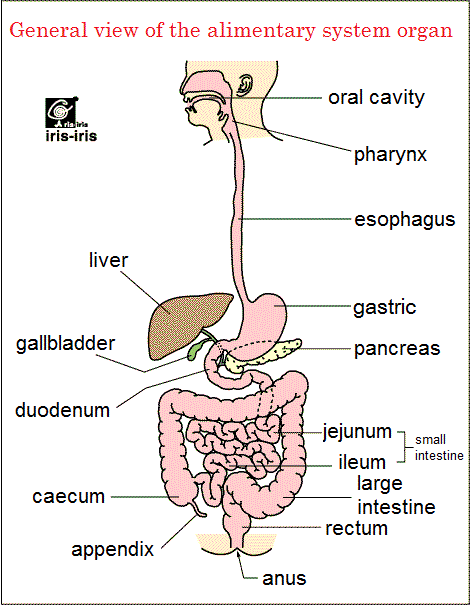 |
||||||||||||||||||||||||||||||||||||||||||||||||||||||||||||||||||||||||||||||||||||||||||||||||
Let’s look at CT image of the belly. |
||||||||||||||||||||||||||||||||||||||||||||||||||||||||||||||||||||||||||||||||||||||||||||||||
| A line is moving in the right picture. The image of the cross section of the line is a left picture. Please do not care about the heart, a lung, a blood vessel, etc. too much, but look at a digestive system.There is an esophagus is behind a trachea. Please see the connection of the stomach, the duodenum, a small intestine, and a large intestine. |
||||||||||||||||||||||||||||||||||||||||||||||||||||||||||||||||||||||||||||||||||||||||||||||||
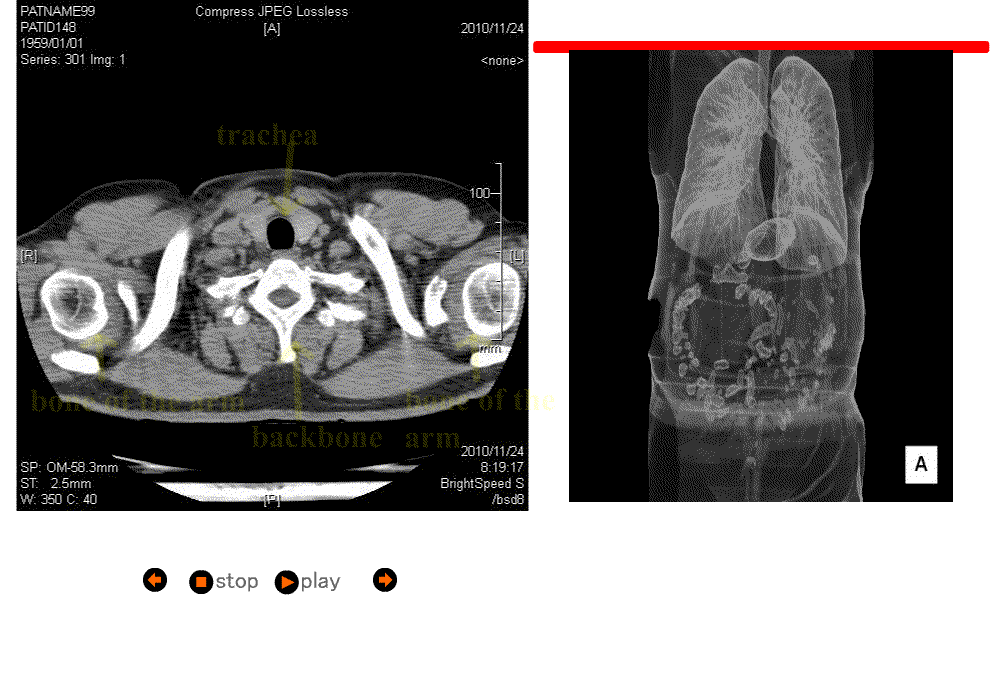 |
||||||||||||||||||||||||||||||||||||||||||||||||||||||||||||||||||||||||||||||||||||||||||||||||
The role of a mouth |
|
A mouth is an entrance for taking in food. In addition, it is a pathway which sends air to a lung, takes in oxygen and takes out carbon dioxide from a lung outside. 1-1.5 liters of saliva are secreted per day. There is a digestive enzyme called amylase in it and changes carbohydrates to malt sugar and small molecules. Let's chew food well and make it fine in a mouth. |
|
気管:trachea、食道:esophagus |
A tongue is shown in red. The yellow shows the soft palate. It is a soft part which we feel when we let a tongue slide in the inner part of the upper jaw in a mouth. Blue part shows an epiglottis. This point follows vocal cords and a trachea. When food moves to an esophagus, a tongue adheres to the upper jaw, a yellow part is extended at back, and the inner part of a throat sticks out forward. The epiglottis play a role of the lid in case foods go in the trachea. |
|
It will probably be very painful when food falls in a trachea before the epiglottis which is a lid is closed. We have a lot of coughs and try to take out the food which entered the trachea  :Please try not to speak with your mouth full during the meals. An epiglottis closes late, and tightly with aging. Please take care of your grandfather and grandmother when you have a meal with them. Even food goes into a trachea, elderly people may not cough very much. They may suffer from pneumonia. It is deglutition pneumonia. |
Esophageal peristalsis |
|
The peristalsis resembles the movement of an earthworm. Please refer to the site below. http://www.mech.chuo-u.ac.jp/~nakalab/study/bm/movie/earthwarm/earthwarm_d.mpg |
|
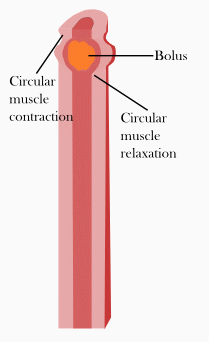 |
We reprint it under the permission of Mr. Taro Nakamura, dpt. of science and engineering, http://www.mech.chuo-u.ac.jp/~nakalab/study/bm/earthwarm.html What was eaten moves forward without flowing backwards. It does not return back. Even we lay down and do a handstand, food moves forward and does not return back. |
Even we do a handstand and are in the state of weightlessness of the spaceship, food is carried to the stomach. |
|
 |
|
 :There are no digestive fluids in an esophagus. :There are no digestive fluids in an esophagus. |
|
An esophagus is a pipe which only sends food to the stomach. |
|
About stomach |
|
| The stomach carries out the peristalsis as well. The digestive fluid in the stomach is pepsin, and it changes a protein to peptone. Peptone is a mixture of various peptide. |
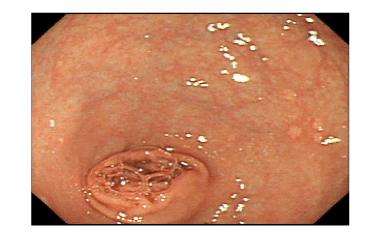 |
The gastric fluid is strong acid, and kills bacteria and the virus leading to infection, or breaks down some toxic substances, and is protecting itself from these. For example, since most of cholera germs die by stomach acid, infection is not caused unless a lot of bacilli are taken in. However, even a little bacteria develop it in the people of the gastric hypoacidity with a little secretion of the gastric acid. Although many bacteria are sterilized by gastric fluid, some are strong to gastric acid like a dysentery bacillus and we are infected by only 100 and under bacilli Some bacteria neutralize stomach acid and live inside stomach like Helicobacter Pylori. |
Temporary storage area to sterilize food with hydrochloric acid included in the gastric fluid not to decay, and to absorb alcohol, and to send food off to the small intestine little by little ※The moving image distributed from TSUMURA Chinese medicine |
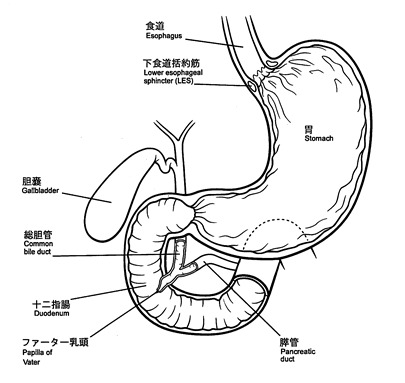
The gastric fluid is made of hydrochloric acid, viscous liquid, and enzymes such as the pepsin, and the daily secretion quantity is approximately 1-2.5 liters. The secretion of gastric fluid is adjusted so that balance may be maintained by a stimulus and control of two factors, a vagus nerve and a humoral factor (gastrin etc.) The movement of stomach is influenced by the activity of the brain as well. When we work without sleeping and take on a trouble, a lot of gastric acid appears, and the mucous membrane of the stomach festers. In other words, we suffer from an ulcer. It is easy for young people to suffer from an ulcer since they have deeper stomach acid and much quantity of secretion. As for the place of an ulcer, a duodenal ulcer is often the case with it. On the other hand, stomach acid becomes thin and the amount of secretion also decreases in it and digestion worsens with aging. If old people have stress, the place out of which stomach acid comes changes, and they suffer from a gastric ulcer more than a duodenal ulcer. |
|
| A size of the stomach | |
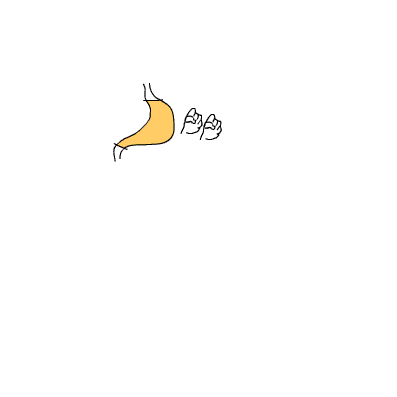 |
When we are hungry, it is a size for two fists and is about 50-100 ml. When we eat a lot, the size becomes 1.5-1.8 L. |
liver, pancreas, gallbladder, duodenum
|
Liver, gallbladder, pancreas are organs attached to a digestive tract, and called the digestive system. We will explain about the role of the liver next time. The gallbladder stores the bile acid made in liver. As shown in a left figure, the tract comes out to the duodenum from the gallbladder. Bile acid flows into the duodenum. The pancreas makes digestive enzymes called a trypsinogen, amylase, and lipase. The pancreatic fluid containing these enzymes is drained from the green tract shown in the left figure to the duodenum. |
The duodenum is about 25cm long and it is like the length which arranges 12 fingers horizontally. The duodenum is also a part of the small intestine. |
|
The next of “duodenum” is jejunum and an ileum. |
|
It is the motion of a small intestine seen with the abdomen echo. |
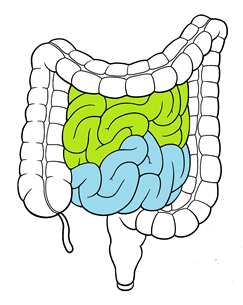
In adults, the length of the tract of the whole small intestine is around 6m (4-7m), and the part of the duodenum is first 25cm of it, and two-fifths of the rest is jejunum (yellowish green part), and three-fifths of it is the ileum (blue part). |
Sugars, amino acid, fat and an inorganic substance, vitamin, water, etc. which were made by being digested are absorbed in a small intestine (the duodenum, jejunum, ileum) and the large intestine. |
|
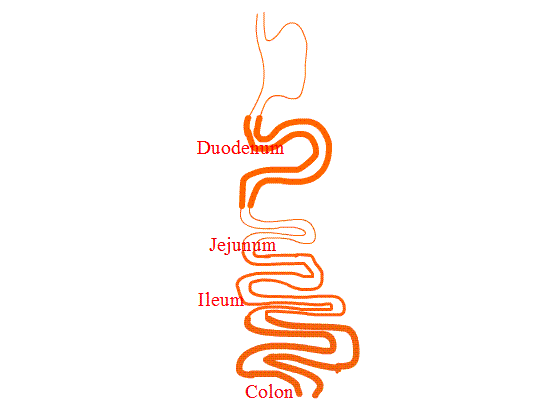 |
|
How long does the food remain in a small intestine and the large intestine? |
| Probably, it takes about 1.5-4 hours for food to be digested with the stomach although it depends on the kind of food.In other words, it remains a few hours. It will be 3-6 hours at a small intestine. It is the long intestine of 6m, but, as for the transit time, it is unexpectedly short. During this time, digestion and absorption are carried out. How about the large intestine? Although length is as short as 1.5-2 m, a digested material remains more than 8-10 hours. |
Absorption at a small intestine |
|
| Amino acid and glucose are capillaries, that is tiny blood vessels which an artery branches in at the small intestine, and are absorbed. Fat and so on are degraded into fatty acids and glycerin, and absorbed by lymph. |
|
|
A small intestine is hard to become a cancer. It is easy to suffer from a disease of the digestive system when we grow up. When we overeat or eat only meat, our stomach becomes weak. It is easy to suffer from a disease of the large intestine which the digested material remains in for a long time. On the other hand, it is hard to suffer from a disease of a small intestine which the digested material does not remain in for a long time.Moreover, the small intestine is said to be an immune organ. There is the tissue called the lymph, and the organ has a strong immune system. |
